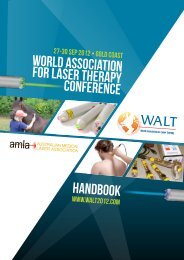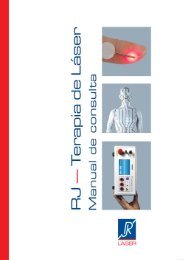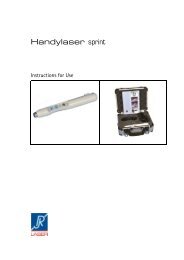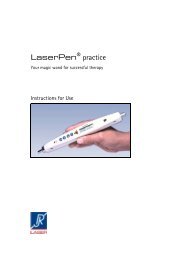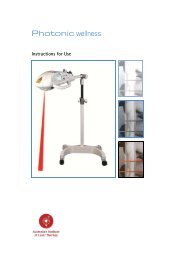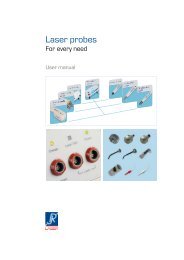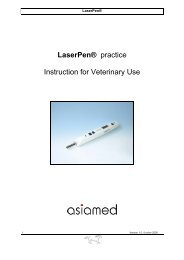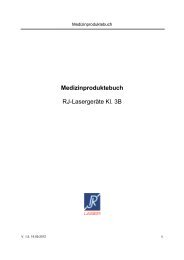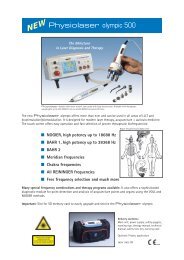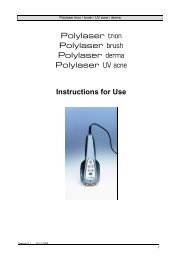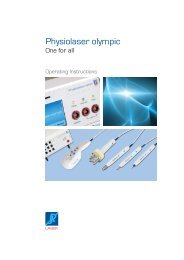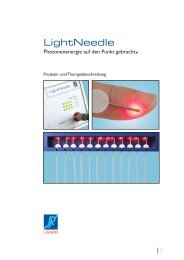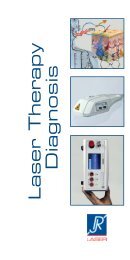LightNeedle - RJ Laser
LightNeedle - RJ Laser
LightNeedle - RJ Laser
Create successful ePaper yourself
Turn your PDF publications into a flip-book with our unique Google optimized e-Paper software.
ment A 1 of the ACA was exposed to ultrasonic waves at<br />
a depth of 58 to 88 mm. The flow direction in the ACA<br />
was opposite from the ipsilaterally applied probe. The<br />
PCA was exposed to ultrasonic waves between 60 and<br />
78 mm and the flow direction in segment Pl was<br />
directed towards the probe.<br />
Near-infrared spectroscopy (NIRS)<br />
The NIRS method allows the monitaring of changes in<br />
cerebral oxygenation through the intact skull, and is<br />
gaining importance in acupuncture research because of<br />
its non i nvasiveness2,6, 17,28=-30,34,36,37.<br />
One equipment für this fjeld of research is the NIRO<br />
300 Monitor (Hamamatsu Photonics, Japan). Measurement<br />
values such as changes in oxyhemoglobin<br />
(AO2Hb) and desoxyhemoglobin (AHHb) are determined<br />
by Lambert-Beer's Principle3,37. With this system,<br />
changes in parameters can be measured absolutely<br />
(Jlmolar), however, the niveau (absolute concentration)<br />
at which these changes (in positive ar negative direction)<br />
occur cannot be determined. As lang as no change in<br />
concentration takes place, the measurement value is<br />
zero. Using a silicone holder, the application of the<br />
probe (emitter and near-infrared detectors) on the head<br />
is simple. Data reproduction of AO2Hb and AHHb was<br />
düne with a color LCD-display and color printer.<br />
2 Neurological Research, 2003, Volume 25,<br />
Volunteers and procedure<br />
Twenty-two healthy volunteers, mean age 24.4 :f: 2.6<br />
years (21-29 years) were examined with LDF and<br />
temperature monitoring. At the time of measurement,<br />
the volunteers were informed about the procedure, were<br />
not under influence of medication and gave their written<br />
consent. In addition, thermography imaging was performed<br />
on two volunteers. This study was approved by<br />
the Ethics Committee of the University of Graz, Austria<br />
(<strong>Laser</strong>needle@-Stimulation; 13-048 ex 02/03).<br />
Continuous measurement of microcirculation parameters<br />
and temperature at the right hand were initiated,<br />
after a resting period of 10 min. When the 'steady-state'<br />
condition was reached, acupuncture point Hegu (Li.4)<br />
on the right hand was stimulated with a laserneedle@.<br />
After cleaning the skin with alcohol, the laserneedle@<br />
was fixed at the acupuncture point with special adhesive<br />
tape. A semi-conductor with an emitting wavelength of<br />
680 nm was used as light source. <strong>Laser</strong> intensity was<br />
rv60 mW.<br />
The LDF-tem~erature probe was applied 1 cm from<br />
the laserneedle .This distance was selected in the<br />
infrared range of 1 cm, based on the given geometric<br />
dimensions of the probe holder and the supposed optic<br />
penetration depth. In addition, temperature at the<br />
measurement point as weil as room temperature were<br />
determined for comparison.



